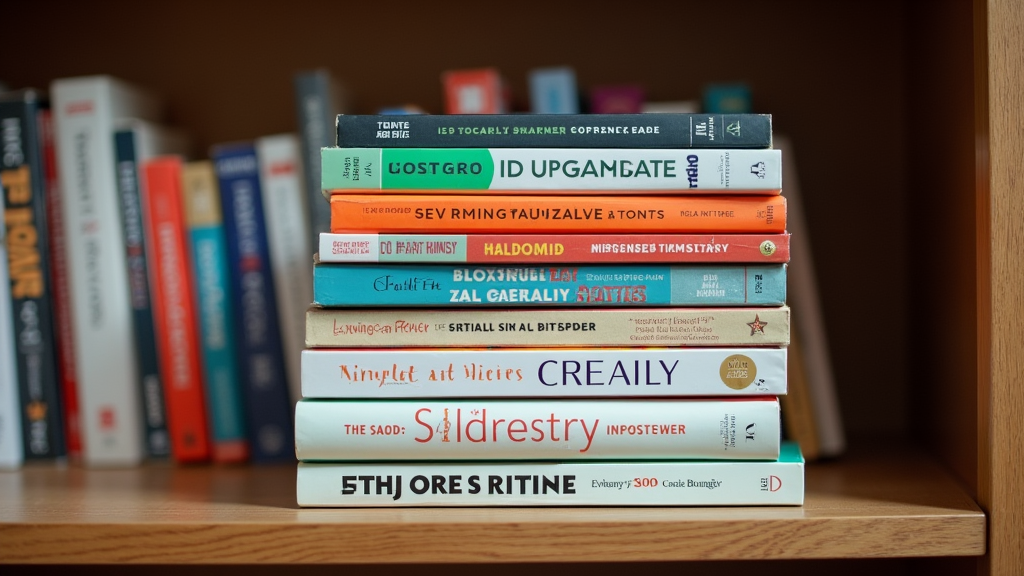“Daring Greatly” by Brené Brown isn’t your typical self help book. It digs deep into the ideas of vulnerability, courage, and the real meaning of connection—stuff that honestly affects every area of my life. Brown’s work is based on years of research as a social worker and academic, but what stands out is how she makes big insights so personal and down-to-earth. This book is about showing up, being seen, and embracing vulnerability in all the messy, real-life ways that actually matter.
Here’s a clear breakdown of key details about “Daring Greatly,” if you’re looking at whether it deserves a spot on your must-read list.

Book Title: Daring Greatly
Author: Brené Brown
Published: 2012
Main Topics: Vulnerability, Courage, Shame, Connection, Leadership, Parenting
Page Count: 320 (hardcover)
Overall Reader Rating: 4.7/5 (average on Goodreads & Amazon)
Notable Recognition: New York Times Bestseller, widely cited in leadership and parenting discussions
Free Preview: YES. Read sample on Amazon
What keeps “Daring Greatly” on people’s shelves long after finishing it is how Brené Brown pairs research with practical advice and honest stories. Whether you’re dealing with confidence at work, authenticity in your relationships, or just want to understand yourself better, this book offers tools and fresh perspectives you can actually use.
Walking into “Daring Greatly” with an open mind, you don’t need an advanced degree in psychology or self-development to get something valuable. Brown writes for real people who want real change—even if that change takes a little courage (and a little humility) along the way.
About Brené Brown: Experience & Approach
Brené Brown is pretty well known for her blend of academic rigor and authentic storytelling. She’s a research professor at the University of Houston and has spent over two decades studying shame, courage, vulnerability, and empathy. But it’s how she talks about her own missteps and uncertainties that makes her work feel so approachable. I remember watching her TED Talk on vulnerability years ago; it’s racked up millions of views for a reason. Brown has a knack for calling out the tough parts of being human, without ever sounding judgmental or condescending.
Brown’s style is equal parts science and heart. She’s interviewed thousands of people about their struggles with shame, trust, and belonging. Her own challenges, everything from parenthood to imposter syndrome, show up in her writing, which adds a layer of credibility and relatability that’s hard to find elsewhere. When she talks about vulnerability, she’s not preaching from a mountaintop. She’s admitting that she finds the work hard, too.
Her core message is that vulnerability isn’t weakness. Instead, it’s our biggest source of courage and creativity, whether we’re leading teams or building families. That’s something I’ve found to be true in my own life, especially during moments that forced me out of my comfort zone.
Why “Daring Greatly” Still Resonates
Since its release in 2012, “Daring Greatly” has found its way into thousands of book clubs, therapy sessions, boardrooms, and schools. There are a few big reasons for this, and from my own experience, the relevance has only grown with time.
- Universal Experiences: Everyone wrestles with vulnerability, even if we try to dodge it. Whether you’re opening up in a relationship or giving a presentation at work, these moments show up everywhere.
- Actionable Advice: Brown translates research into steps I can actually try out; no mystical rituals necessary. The book gives language for struggles I hadn’t even realized needed naming.
- Cultural Impact: The phrase “daring greatly” gets tossed around in conversations about leadership, creativity, and even parenting. I’ve seen it referenced everywhere from classrooms to corporate workshops.
- Changes with Life: As I hit new phases of my life, Brown’s ideas mean something different. When I first read it, I focused on personal insecurities. Later on, it helped with tough feedback at work. Lately, it’s shown up in parenting, friendships, and how I deal with uncertainty.
I keep coming back because “Daring Greatly” is both big picture and super practical. It doesn’t shy away from hard emotions, but it never leaves you stuck there, either.
Core Ideas: Understanding Vulnerability
At its heart, “Daring Greatly” is all about vulnerability—not in a sappy or overly dramatic way. If you’re picturing people oversharing their deepest secrets online, that’s not what Brown means. Vulnerability, the way she describes it, is simply about the willingness to be seen, to show up, and to take emotional risks, even when you can’t control the outcome.
Brené Brown defines vulnerability as “uncertainty, risk, and emotional exposure.” This happens way more often than we realize. Think about when you ask someone out, admit you made a mistake at work, say “I love you” first, or stand up for an unpopular idea. Those are all moments where something personal is on the line, and you’re not totally sure what’s going to happen next.
What Brown’s research found is pretty eye-catching; people who lean into these moments, instead of hiding from them, end up feeling more connected, confident, and creative. Vulnerability is actually the birthplace of stuff like trust, innovation, and real relationships.
Main Myths About Vulnerability
Brené Brown spends a good chunk of the book busting myths about vulnerability that are surprisingly common. Here are a few that really stuck with me:
- Myth 1: Vulnerability is weakness.
Most of us are taught that showing our true feelings or not having all the answers means we’re weak. Brown’s research flips this idea; she shows that it actually takes guts to face uncertainty. - Myth 2: I can do it alone.
Trying to solve every problem yourself, or refusing to ask for help, isn’t a strength. It’s a way to keep people at a distance. Brown argues that interdependence isn’t a flaw; it’s fundamental to real connection. - Myth 3: Vulnerability is oversharing.
Brown is super clear that being vulnerable doesn’t mean telling everyone everything. It’s about sharing with people who’ve earned your trust, not blasting your private struggles to the whole world.
After thinking about it, I realized how many times I’d played it safe to avoid being vulnerable, whether it was dodging tough conversations or holding back new ideas. Brown’s message helped me see that those moments were the real opportunities for being brave, even if my voice shook or my stomach was tied in knots.
The Power of Shame and Empathy
“Daring Greatly” really digs into shame—a feeling so uncomfortable many of us try to avoid even thinking about it. Brown defines shame as the fear that we’re unworthy of love and belonging. Her big thing is this: shame grows in silence, secrecy, and judgment. When we name it, share it with someone who understands, and show ourselves compassion, shame loses its grip.
Empathy turns out to be a major antidote. It’s not about fixing other people’s problems or offering quick solutions. It’s about listening without judgment and letting someone know they’re not alone. As I started to practice empathy, in my own awkward ways, I found that being open about my mistakes or insecurities helped others open up too. The result? Conversations got deeper and relationships started to feel less performative and more real.
Here are some practical moves Brown suggests for dealing with shame and building empathy:
- Recognize Shame Triggers: Stress, rejection, or criticism can set off shame. Recognizing those triggers helps me prepare and respond instead of shutting down.
- Reach Out: Telling at least one trustworthy person about what I’m feeling helps break shame’s hold. Even a simple “This is hard for me to say…” makes a difference.
- Practice Self compassion: Being kind to myself instead of judging harshly helps me move through tough feelings instead of getting stuck.
- Model Empathy: Listening to someone’s tough experience without interrupting or problem-solving shows them they’re not alone.
The book offers scripts, reflection questions, and stories that make these ideas easier to put into practice, whether you’re a leader, parent, or just trying to be a better friend.
Application in Real Life: Work, Parenting, and Relationships
What’s really useful about “Daring Greatly” is that it doesn’t just hand you ideas and walk away. Brené Brown explains how these concepts work in daily life, from boardrooms to kitchens. I’ve seen a little extra courage in each part of my life thanks to this book, so here’s where the rubber meets the road.
Vulnerability at Work
If you’ve ever worried about looking “unprofessional” by admitting you don’t know something, you’re not alone. Workplace culture often rewards always having an answer, or at least pretending you do. Brown argues that admitting uncertainty or asking for help makes you a stronger, more trusted leader. She also covers:
- Giving and receiving feedback, especially when it’s uncomfortable.
- Addressing mistakes instead of covering them up.
- Encouraging innovation by making it safe to take risks and fail.
One story in the book that I think about often comes from a manager who switched up team meetings from “Who messed up?” to “What did we learn?” That simple change made people more willing to share creative ideas, and even flag problems early, which made the whole team stronger.
Parenting and Vulnerability
Brown writes a lot about parenting, and as someone who sometimes stumbles through the tough questions kids ask, it’s reassuring to know that “perfect parenting” isn’t the goal here. Instead, Brown focuses on raising kids who are resilient and can talk openly about their emotions.
- Letting children see you struggle, apologize, or not have all the answers teaches them it’s okay to be imperfect.
- Encouraging them to ask for help instead of pushing them to “tough it out.”
- Using empathy and curiosity, instead of jumping straight to discipline when something goes wrong.
Even when situations get heated, taking just a second to notice shame triggers can turn a tough moment into an opportunity for connection. It’s not about having flawless responses; it’s about showing up and being real.
Relationships and Friendships
The influence of vulnerability on relationships is probably the thing that hit home for me most. Brown shows that durable bonds are built on mutual trust and the willingness to risk emotional exposure. This means:
- Allowing others to see you when you’re uncertain or afraid, instead of just presenting a “filtered” version of yourself.
- Letting go of perfectionism; nobody wants to feel like they’re only loved for being flawless.
- Weathering conflict with honesty, rather than pretending nothing’s wrong or bottling up resentment.
All of us crave real connection, but it only happens when we’re willing to be seen—warts, awkward silences, and all. “Daring Greatly” doesn’t make this easy, but it does provide a roadmap for practice.

Breaking the Perfectionism Trap
Perfectionism is a huge theme in “Daring Greatly.” Brown describes it as the belief that if you look perfect and live perfectly, you can avoid shame, judgment, and blame. But, in real life, this mindset leads to stress, disconnection, and missed opportunities.
I always thought striving for perfection was helping me get ahead, but Brown points out that it’s actually just a shield; it keeps us on the sidelines and afraid to try new things. Perfectionism isn’t about healthy achievement or growth. It fuels self-criticism and turns mistakes into disasters instead of learning moments.
Switching gears from chasing perfection to aiming for “good enough” or “done is better than perfect” has been a game changer for me. It’s helped me take more risks and celebrate progress instead of obsessing over flaws. Brown’s “wholehearted living” framework offers a practical alternative—you build resilience and courage by being imperfect, not despite it.
Leadership Lessons from “Daring Greatly”
This book is loaded with insights for leaders or anyone who finds themselves influencing others, at work, in community groups, or even in families. Brown describes “wholehearted leaders” as people who model vulnerability, own their mistakes, and create environments of trust and curiosity.
- Admit When You Don’t Know: Leaders who are open about what they don’t know signal that it’s okay for others to be honest, too.
- Model Feedback: Constructive feedback, delivered with empathy, not blame, builds climates where people actually improve.
- Normalize Failure: Instead of punishing mistakes, teach people to see them as steps toward learning. It’s amazing how much creativity gets unlocked when people stop feeling like they’re always balancing on a tightrope.
- Courage Over Comfort: Encourage tough conversations and new experiments, even if it’s scary or unfamiliar. Brown’s stories about organizations that jump into these moments show that they thrive in the long run.
Some of the most effective teams I’ve worked with used principles straight out of this book. There was less posturing, more honest talk, and higher trust. The research supports this: vulnerability-based trust is a stronger predictor of engaged, effective teams than any technical skill you can list on a résumé.

How “Daring Greatly” Shapes Culture
Brown talks a lot about how vulnerability—or the lack of it—shapes entire groups, not just individuals. She introduces the idea of “cultures of scarcity,” where people feel there’s never enough: not enough time, resources, recognition, or grace for mistakes. In those environments, everyone walks on eggshells, and innovation tanks.
Switching from a culture of scarcity to a culture of “enough” means leaders and members are encouraged to show up as themselves, even if it’s awkward or hard. The effects? More open communication, stronger relationships, and better results across the board.
- Building Belonging: Making space for all voices, not just the loudest or most powerful, leads to real engagement.
- Reframing Feedback: Treating feedback as a way to help each other grow, not as a personal attack.
- Celebrating Effort: Recognizing people for showing up and taking risks, not just “winning.”
After having seen both toxic and healthy team cultures, I can safely say the difference is glaring. Teams that foster vulnerability may not look perfect on the outside, but they usually get more done and have more fun along the way.
Practical Tools and Exercises
“Daring Greatly” isn’t just theory. Brown includes plenty of exercises that help move these principles from the page into everyday life. Here are a few that I’ve tried (and recommend):
- Shame Resilience Building: When you catch yourself spiraling into shame, pause and ask: Where did this come from? Is it true? Who can I talk to about it?
- The Courage Practice: Pick one opportunity—even a tiny one—to speak up, ask for feedback, or share an idea. Notice what happens. Celebrate that you dared, no matter the result.
- Empathy Mapping: In tough conversations, try to step into the other person’s shoes. What might they be feeling, fearing, hoping for? This resets the tone from attack/defense to understanding.
- Parenting Reflections: At the end of your day, ask yourself, “Was I willing to be seen by my kids—mess-ups included?” If not, choose a small way to share more honestly with them tomorrow.
Brené Brown also suggests journaling prompts and discussions to have with family or team members. Even a 5minute daily review can make big switches happen over time.

Top Quotes from “Daring Greatly”
Some lines from this book have stuck with me for years. Here are a few worth jotting down, sticking on your fridge, or using as mental reminders when life feels tricky:
- “Vulnerability is not knowing victory or defeat, it’s understanding the necessity of both. It’s getting involved. It’s being all in.”
- “Shame corrodes the very part of us that believes we are capable of change.”
- “Courage starts with showing up and letting ourselves be seen.”
- “Perfectionism is not the same thing as striving for excellence. Perfectionism is not about healthy achievement and growth.”
- “Connection is why we’re here. It’s what gives purpose and meaning to our lives.”
Having these in my head helps me push through tough spots, whether I’m facing a blank page, an argument, or a new challenge that makes me nervous.
Common Questions (and Honest Answers)
People ask me all the time if “Daring Greatly” is worth the hype, or if it’s just another motivational book that gathers dust after the first read. Here’s what I usually say:
- Is it only for people struggling with confidence or shame?
Not at all. Even if you feel pretty secure, there are always situations, like career moves, parenting, or relationships, where vulnerability makes a difference. - Do I need to have read Brené Brown’s previous books?
No background required. Brown repeats key research gently and focuses on practical application, so you can start here and circle back to earlier books if you want more depth on specific topics. - Is it more for leaders or personal growth?
Both. Parents, coaches, managers, creators—anyone who deals with other humans can find value. The leadership sections are super practical, but there’s plenty for anyone focusing on self discovery. - Is there actual science behind the advice?
Yes. Brown’s research base is robust, and her work is referenced in academic and professional circles. But she keeps it readable, with lots of stories to back up the stats.
I’ve found that even people who are skeptical about self help have resonated with how grounded and no-nonsense Brown’s approach is.
The Ripple Effect: After Reading “Daring Greatly”
The biggest mark of a great book is what happens after you finish it. Here’s what’s changed for me and for plenty of others I’ve chatted with:
- Better Boundaries: It’s easier to say no, admit when you’re stretched, and let go of needing to please everyone.
- Deeper Conversations: Sincere questions replace small talk. Honest “I don’t know” moments pop up more often, and connection grows stronger.
- More Creativity: Taking creative risks, whether at work or home, becomes less scary when you accept you might not nail it the first time.
- Breathing Room for Failure: Messing up is less of a catastrophe. Brown’s advice helps turn flop moments into learning, not shame spirals.
This isn’t a book you read once, nod, and forget. I keep coming back to the ideas when life gets tough or I catch myself falling into old habits. “Daring Greatly” is a guide for the long haul, not a quick emotional boost.
Is “Daring Greatly” for You?
If you’re wondering whether this book will actually help in your specific situation, here are a few pointers. It’s worth checking out if you:
- Want to let go of self-doubt or the need to seem perfect all the time.
- Lead a team, parent a child, teach, coach, or care for others (even if just occasionally).
- Feel like surface level conversations aren’t cutting it and want more realness.
- Are navigating change, conflict, or big transitions.
- Enjoy books that mix research, real stories, and concrete tools.
It might not hit as hard if you’re totally satisfied with how things are, or if you’re looking for a super strict step by step action plan. But even then, small tweaks inspired by Brown’s ideas can make things a lot more meaningful and connected.
Other Books and Resources by Brené Brown
If you finish “Daring Greatly” and want to keep going, Brené Brown has written several other books that each focus on different angles of vulnerability and leadership. Here are a few you might want to check out:
- “The Gifts of Imperfection” – Great intro to wholehearted living and letting go of who you think you’re supposed to be.
- “Rising Strong” – Focuses more on resilience and how to recover after things fall apart.
- “Braving the Wilderness” – Digs into what it means to truly belong, even in uncertain times.
- “Dare to Lead” – If you’re looking specifically for workplace and leadership applications, this one’s a must.
Brown also has a couple of Netflix specials (like “The Call to Courage”) that are worth streaming, plus her Unlocking Us podcast covers lots of related topics.
How to Get the Most From “Daring Greatly”
Jumping into a book like this is more rewarding if you actively use what you read. Here are some tips that have worked for me and for folks in book groups I’ve joined:
- Read with a buddy: Having someone to talk through the exercises and tough moments with helps keep you accountable and less likely to dodge the uncomfortable bits.
- Take notes: Whether you highlight in the margins or keep a journal, jotting down reactions makes the book stick with you past the last chapter.
- Pause and practice: Every so often, set the book down and try an exercise in real life, whether it’s asking a new question at dinner or reflecting after a challenging day.
- Circle back: Certain chapters (like those on shame or leadership) might not hit now, but they could later on. Don’t be afraid to revisit.
This isn’t a book that’ll solve everything overnight, but consistent effort brings real improvements. At least that’s been true in my circle.

Media, Reviews, and Broader Impact
Since its release, “Daring Greatly” has become more than just a book; it’s a cultural touchstone. If you search online, you’ll find everything from glowing testimonials in The New York Times to critical takes on psychology forums, plus lots of summary videos on YouTube.
User reviews on Goodreads and Amazon consistently highlight its fresh take on old struggles. People mention that it feels like Brown is “speaking directly to them.” The book is often assigned in leadership training, therapy, and organizational development. In workplaces, I’ve seen sections used as opening prompts for tricky team meetings, while in personal life, more than once I’ve heard, “That’s straight out of ‘Daring Greatly.'”
I see the impact daily—from how I interact with colleagues to the questions I ask friends or family when they’re struggling. It’s sparked conversations on anxiety, imposter syndrome, raising emotionally intelligent kids, and even how to give feedback in a way that builds trust instead of resentment.
For more super detailed reviews and breakdowns, check out:
Quick Skim: Key Takeaways From “Daring Greatly”
- Vulnerability is courage in action, not a sign of weakness.
- Shame thrives in silence; empathy disrupts its cycle.
- Perfectionism keeps us small; connection requires authenticity.
- Leaders (and parents) who model vulnerability build trust and resilience.
- Small daily acts of courage create cultures of belonging and innovation.
If you remember nothing else, know that being brave and vulnerable—at work, at home, with friends, or even just with yourself—opens up space for growth, creativity, and connection.
Pricing and Where to Buy
“Daring Greatly” is widely available online and in bookstores. Here’s a quick look at options if you’re ready to grab a copy:
- Amazon (new/used): Paperback $10–16, Kindle $11; View on Amazon
- Bookshop.org: Supports local bookstores, similar pricing; Order here
- Audible: Audiobook accessible with free trial or membership; Try it here
- Libraries: Most public libraries carry copies or can request interlibrary loans if you want to borrow before you buy.
There’s usually a free preview or sample on the publisher’s site or Amazon, so you can test-drive a few chapters first.
Final Thoughts and Next Steps
Speaking from experience, “Daring Greatly” isn’t preachy or condescending. It feels a bit like having an honest chat with a wise friend who can also break down the research, so you know the advice isn’t random. Some parts may hit uncomfortably close to home—it did for me, especially on shame and perfectionism—but that’s honestly where the best growth happens.
If you’re willing to try some new ways of responding to stress, criticism, or tough conversations, this book gives you real tools for doing that. If you’re curious where to start, my suggestion is simply to notice everyday moments where vulnerability pops up, and ask yourself what would happen if you leaned in just a little.
For anyone wanting to explore more, check out the official “Daring Greatly” book page for discussion guides, bonus content, and even reading group suggestions. I’m happy to chat more about how the ideas show up in real life; just drop a comment below or reach out through the links above. Being brave together is way less scary than going it alone.

Chris is the voice behind Daily Self Wisdom—a site dedicated to practical spirituality and inner clarity. Drawing from teachings like Eckhart Tolle, Ramana Maharshi, and timeless mindfulness traditions, he shares tools to help others live more consciously, one moment at a time.Learn more about Chris →
Leave a Reply